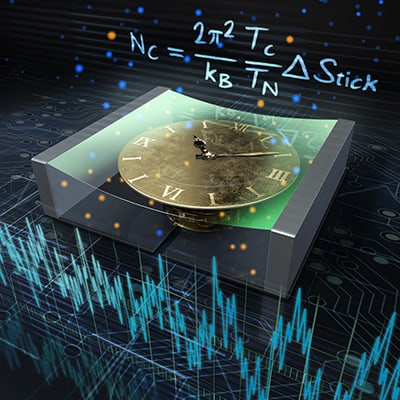
Imagine the sound of a ticking clock. How much time passes between each tick? For a good clock, the answer should be one second, to some precision. If we want to make the clock more precise, the laws of thermodynamics dictate that we must put in more work – and the amount of waste heat dissipated to the surroundings must increase to compensate for the more highly-ordered ticks. Ultimately this leads us to a surprising, but inescapable result: the better we make our clock, the more we increase the disorder, or entropy, of the universe.
In 2017, physicists showed that the accuracy of a quantum clock is directly proportional to the entropy created. Now, researchers in the UK and Austria have discovered that a similarly proportional relationship holds for a nanoscale classical clock. The work, published in Physical Review X, hints that not only does measuring time necessitate some entropy increase, but also that the exact relation between the accuracy of clock ticks and the entropy produced may be a universal aspect of timekeeping. The result could have implications for nanoscale heat engines, which operate in a similar way to clocks, and technologies that depend on accurate timekeeping.
Synchronizing the quantum and the classical
Testing the link between accuracy and entropy is hard in a classical system because it is so difficult to keep track of the transfer of heat and work. To overcome this barrier, Natalia Ares and her team at the University of Oxford worked with colleagues at Lancaster University, the Institute for Quantum Optics and Quantum Information, and the Vienna Center for Quantum Science and Technology to create a simple optomechanical “nano-clock” consisting of a membrane driven by an electric field. The displacement of the membrane as it wiggles up and down is recorded, and each wiggle is counted as a clock tick. The clock has a useful output – a train of ticks – at the expense of increasing the disorder of its environment by heating the circuit connected to the membrane.
This nanoscale system was too large to be analysed quantum mechanically, and it was also physically entirely different to the quantum clocks studied previously. Nevertheless, the researchers found the same type of relation between accuracy and entropy as in the quantum clocks. The relation between clock accuracy and waste entropy in the experiment is also consistent with the researchers’ theoretical model, confirming that the pattern can hold for classical models as well as quantum ones.
Redefining optimal
Although the researchers only tested the relation between entropy and accuracy for one specific implementation of a classical clock, they claim that the similarity to the quantum result suggests that it may hold true for any clock. The researchers also suggest redefining an “optimal” clock as being one that has the highest possible accuracy with the least entropy dissipation (according to the discovered relation between accuracy and entropy), independent of the clock’s physical details.

Quantum coherence turns up the heat on Maxwell’s demon
Writing on the Oxford Science Blog, Ares suggests that the relation between accuracy and entropy “might be used to further our understanding of the nature of time, and related limitations in nanoscale engine efficiency”. One major open question concerns how the so-called “arrow of time” manifests itself on small scales and quantum scales. The arrow of time is often defined as being the direction in which entropy increases; inversely, all clocks use entropy increase in some form to quantify the passage of time. A better understanding of the measurement of time could thus provide new insights into how heat, work and time’s arrow are connected.



